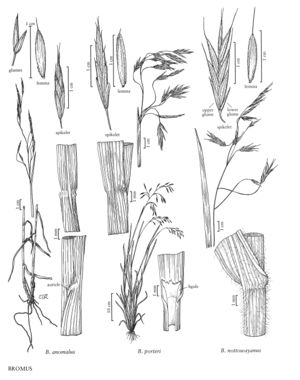Bromus anomalus
Plants perennial; not rhizomatous. Culms 40-90 cm, erect; nodes (3) 4-7 (8), these and the internodes pubescent or glabrous. Sheaths glabrous or pilose, midrib of the culm leaves abruptly narrowed just below the collar; auricles often present on the lower leaves; ligules to 1 mm, truncate; blades 14-22 (26) cm long, to 6 mm wide, flat, glabrous or pilose, not glaucous. Panicles 10-20 cm, open, nodding; branches ascending or spreading. Spikelets (14) 15-30 mm, elliptic to lanceolate, terete to moderately laterally compressed, with 4-12 florets. Glumes usually pubescent, rarely glabrous; lower glumes 5-6 mm, 1-3-veined; upper glumes 6-8 mm, 3-veined, sometimes mucronate; lemmas 7-10 mm, elliptic to lanceolate, rounded over the midvein, backs and margins pubescent, apices acute to obtuse, entire; awns 1-3 (5) mm, straight, arising less than 1.5 mm below the lemma apices; anthers 2-4 mm. 2n = 14.
Distribution
Alta., B.C., Sask., N.Mex., Tex.
Discussion
Bromus anomalus grows on rocky slopes in western Texas and adjacent Mexico. Many records of this species in the Flora region are here treated as B. porteri, a closely related species that has sometimes been included in B. anomalus. The main difference is that B. anomalus has auricles, and culm leaves with midribs that are narrowed just below the collar.
Selected References
None.
Lower Taxa
"decumbent" is not a number.
